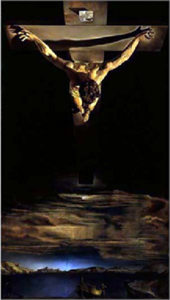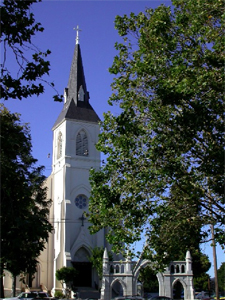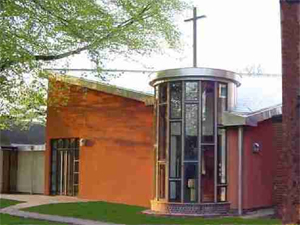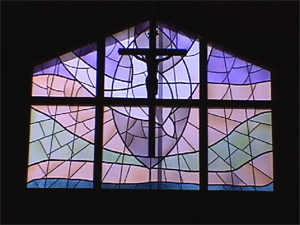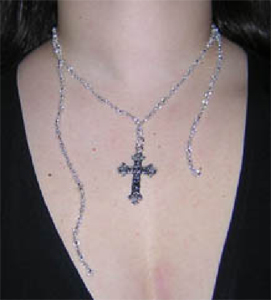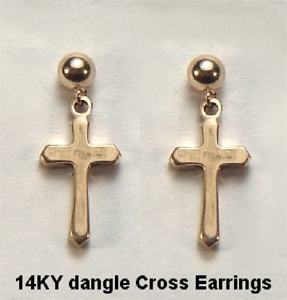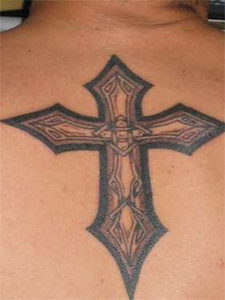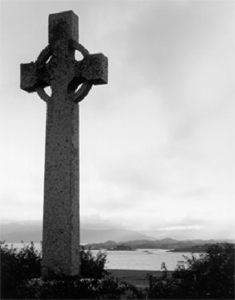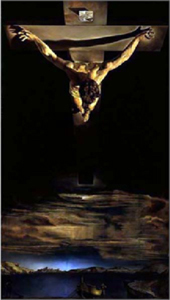
Christmas
Easter
Pentecost
All Saints
Christ The King
Confirmation
Palm/Passion
Reformation
Stewardship
Books of the Bible
Lenten Series
Christmas Dramas
Videos
Series A - Matthew
Series B - Mark
Series C - Luke
Series D - Other
To contact
Edward F. Markquart
info@sfs.com

Series A The Cross: The Hidden Face of God Lent 3A I Corinthians 1:18 Also: Epiphany 3A and 4A, Lent 3B, Holy Cross Sunday, Palm and Passion Sunday “For the word of the cross is folly to those who are perishing, but to us who are being saved it is the power of God.” I Corinthians 1:18 My first memory of the cross is as a boy growing up in Jackson, Minnesota. Jackson, Minnesota is my hometown. It is located in southwestern Minnesota, six miles from the Iowa border. It is a farm town of three thousand people. That little farm town shaped my life in my formative years. I loved that city. In fact, I often wish my children could grow up in a similar kind of quiet rural community. Jackson, Minnesota, is located in the bottom of a valley. Imagine a bowl (like you were having a bowl of cereal) and down in the bottom of that bowl is our little community. As you approached our city from the north on Highway 71, you came to the brink of a high hill, the edge of the bowl. Just as you were at the brink of that hilltop, you have this breath-taking panoramic view of the city below. And at night, as I remember, it was absolutely gorgeous. You could see all the lights of our little city, down there in the bowl beneath you. The following story, like so many stories, is a blend of fact, fiction and caricature. In 1955, the evening skyline changed. The Methodists started to build a gorgeous new church on the east side of town. It was the most lavish building that Jackson had ever seen. These Methodist farmers were rather wealthy, and they could afford a big church. There on the top of that beautiful new Methodist Church was a gigantic slender spire, and on the top of that tall steeple was this inspiring cross. Sleek, slender, beautiful. It was also decorated with a pink neon light. And so this pink cross could be seen against the evening sky; a new bright, crimson evening star. As I recall, it was given by a wealthy farmer who had pink carpet in his living room. And in the eyes of many people, that sleek, slender, pink cross was absolutely gorgeous as you came driving into town at night. And most importantly, when all the truck drivers came driving into Jackson at midnight, as they came to the crest of that big hill outside of town, their lives were touched; their lives were inspired and moved by that pink Methodist Church cross silhouetting its simple beauty across the evening sky. Well, needless to say, the Lutherans felt a little uncomfortable with the pink Methodist cross. They didn’t say it openly, but the feeling was there. They didn’t want to be a step behind the Methodists in witnessing to the truck drivers, and these Norwegian Lutherans wanted all of the world to know, and especially the truck drivers, that they too were witnessing Christians. And soon the Lutherans were designing a new cross for their church steeple. They had a problem. Their steeple wasn’t as high as the Methodist’s. They had to solve that problem. Something had to be done, so the Lutherans created a wide, stout cross. It was bold and solid like we Lutherans are supposed to be, white and pure in color. This new cross was flooded with the brightest lights so that it could be seen for miles at night. And so when the truck drivers came driving into Jackson, Minnesota, in the evening, they now had two crosses to inspire them - the pink cross of the Methodists to the east, and the Lutheran cross in the center of the city. But unfortunately, as you have perhaps figured out by now, the Roman Catholics didn’t want to be outdone. And the Roman Catholics were on the far west side of town. They needed a new church, and they, too, needed a new spire, and they definitely needed a new cross. Their cross was made out of the shiniest brass with bright golden hued lights illuminating its reflective beauty. And so, there were three beautiful crosses dotting the evening skyline; just like at Calvary: one, two, three. And importantly, most importantly, the Lutheran cross was the center one, the middle one, the solid one, on which Jesus died (so all the Lutherans quietly told themselves, but no one else). And such was my first and fond memory of the cross; the emblem, the pink emblem of Jesus silhouetting himself on the sky. The cross is and always has been the primary symbol of the Christian faith. Humorously, sometimes, made out of Popsicle sticks, egg cartons, and plastic; lovingly covered with yellow sequins, glittering gold, Pepsi bottle caps, and neon lights. And it is found on dashboard, chimneys, water towers, desks, earlobes, and bosoms. And regardless of all the sizes and shapes; and regardless of all the colors, commercialization, and corniness, no other symbol has so captured the imagination of Christians as the cross. For us Christians, no other symbol illustrates what it means to be a Christian and walk the “way of the cross.” No other symbol so clearly illustrates for us the passionate love of God, the height and depth and length and breadth of God’s compassion. The cross is the singular symbol of the Christian faith. For Christians throughout the centuries, the cross captures the essence of Christianity: the passionate love of God. The cross is the central symbol of the Christian faith. Let us look at some images of the cross.
In this painting, we can see and feel the pain in Jesus’ body, that Jesus’ suffering was not imaginary or pretend, but that Jesus actually suffered a painful death on your behalf and mine. A cross with a body on it is called a crucifix. It symbolizes the pain and suffering of Jesus on the cross. It is THE cross of Passion Sunday; it is THE cross of Good Friday.. The cross is the central symbol of the Christian faith. Look at the next painting.
In this painting by Salavor Dali, we vicariously experience the cross. We know what this cross means: that Jesus died for the sins of the WHOLE world. His head is looking down at the WHOLE world. His arms are outstretched for the WHOLE world. Look at the next painting. The cross is the central symbol of the Christian faith.
We have all played the game and seen the game played, with a parent saying to a child, “How much do I love you? From the cross, the primary symbol of the Christian faith, we know that the Lord God loves us thiiiiiiiiiiissssss much, without our hands stretched out as far as they can go. Jesus is facing us, is facing the WHOLE world and saying, “I love you this much.” That is the message from the cross. The cross captures the passion; the cross captures the compassionate love of God for all people. The cross, the central symbol of the Christian faith, is found every place, including on the top of church spires…
The cross is high and lifted up, in order to inspire us. We recall the hymn, LIFT HIGH THE CROSS. The cross is to be high and lifted up in order to catch our attention and inspire us. (Next.)
We see the cross high and lifted up on very old churches from yesteryear. (Next.)
We see the cross high and lifted up on modern churches that were built yesterday. (Next.)
Up in the front chancel of most churches, you will find an image of the cross. Here within our own chancel area, we see numerous crosses: the processional cross, the cross standing behind the totem, the five crosses on the top of our communion table, and the five stars in the window which for me represent the five crosses and five wounds of Christ. (Next.) Numerous people wear cross necklaces.
People wear cross ear rings.
Some people even wear cross tattoos on their bodies. Not many in our parish, but a woman after the last service showed me her tattoo of the cross on her wrist.
Always, the cross is to be high and lifted up in order to inspire our lives to be compassionate like Christ. It is to be bold and look out to the world that God loves. (Next.)
Yes, the cross the central symbol of the Christian faith. For God SO LOVED THE WORLD that he gave his only begotten Son.
The cross captures the compassionate love of God for us, the height and depth, the length and breadth of God’s love, like no other religious symbol. This symbol, more than any other, is the window through which we can look to see the face of God himself. What does God look like? Can you tell me what God looks like? Can you tell me what his face resembles? Look through the cross and you will be able to see the presence of God face to face. And that is what I would like to talk with you about today: God’s face as seen through the window of the cross.
You see the face of passionate love, of a passionate lover. His feelings are filled with intensity and emotion, for the face of God is the face of a passionate lover, the face of passionate love. And what immediately comes to your mind when you think of the phrase, “passionate lover” or “passionate love?” Do you not think of a large movie screen with a face of a famous lover? From movies of yester year, you may think of the face of Rudy Valentino or Clark Gable. Or from yesterday, the faces of Sean Connery or Robert Redford. Or from today, the faces of who Dr. McDreamy or Orlando Bloom. When you think of a passionate lover, you think of a face of a famous romantic symbol from American movies. Or when you think of a passionate lover, you may visualize one of those passionate love scenes in the movies, when a kiss between and man and woman goes on breathlessly, on and on and on. When you see a steamy love scene on TV, it seems as if the TV is smoking and steaming with passion. When we think of the phrase “passionate lover” we usually think of a love scene at the movies. But I am using the word, “passionate” very carefully. If you go home and look up in your sermons, the Latin word, “passion” means suffering. If you go home and look up the word “passion” in your dictionary, you will discover that it primarily means suffering. The word “passion” does not refer to some madly intense, French kissing, slobbering, breathlessly clutching, sex scene that has little or nothing to do with passionate love. That has to do with sex. If you go home and look up in your dictionary what the word “passion” means, you will discover that passion has nothing to do with breathlessness. Passion means suffering. And today we are talking about the passion story, the suffering story of God on the cross. And God is passionate love, a passionate lover, a lover who passionately loves and suffers in pain with us. He loves us with complete abandonment, taking our pain upon his shoulders, and it is only through the window of the cross that we see the face of God, face to face. His face is the face of a passionate lover and not that of a movie star. I would like to share with you three stories of three faces that show passionate love. I think of parents and their passionate love for their sick children. I think of those parents whose children are in Children’s Hospital in downtown Seattle or in Mary Bridge Hospital in Tacoma. EVERY single parent who has a child seriously sick in Children’s or Mary Bridge goes to be with their child. You couldn’t keep such parents away from their child and his/her pain. There is a look in their face. There is a look in their eye. There is a body language. This is passionate love. Love that embraces the pain of another. Such is God’s love for us. God is passionate love. God comes to us in our pain. No matter where we are or how terrible the burden is, God is passionate love and comes to be with us and strengthen us during each and every painful moment. Let me two other stories of people whose face reveals passionate love. And God is passionate love, a passionate lover. The word “passionate” means suffering, and refers to the one who suffers with us and for us. It is only through the cross that you see the face of God as the passionate lover, the one who suffers. From years ago. It’s about a friend of mine. Jack. I knew Jack back in Madison, Wisconsin, years ago. I was working there in as a youth director in a church, and Jack was a member of this congregation. He was a great kid, a fine young man. He was a gifted athlete and held the high school track record in the 440 dash. I loved and admired young Jack. I moved away from Madison, and Jack joined the Marines. He went to Vietnam. In 1966, a grenade was tossed into a group of young men who were in a foxhole together. Jack instinctively dived onto that grenade and was blown to bits. He was killed instantly, and thereby some of his friends are living today. Jack voluntarily gave his life that others might live. And such was his love for others. I saw his mother afterwards at the funeral. She wished her son wouldn’t have done that. Her heart was breaking because of what her son had done. And such is passionate love. It is a love which is willing to die for others. The few times that I have been in Washington, D.C., I always visit the Viet Nam memorial and look up the name of Jack and stand before that long, black wall remember “this kid” from long ago and grieve. And such was the passionate love of God for us. His love for us was that he was willing to give up his Son for us. That is the passionate love of God, that he was willing to sacrifice his Son on the cross for you and me. And God loved his little boy just as much as all of you parents love your sons and daughters. God loved his little boy just as much as any parent loves their son or daughter. And the heart of God was breaking, as he saw his Son suffer and die on the cross. A parent suffers with a child. A parent dies with his child. God is passionate love. Another story. My cousin, Lois, died of cancer. She was a young woman, about my age, and she died of bone cancer at the age of thirty-five. I will never forget my last visit with her. She was sitting in her living room, looking down on Lake Oswego in Oregon. I will never forget my last visit with her, nor will I forget afterwards when I went into the kitchen with her mother. When the door was closed, and we were out of earshot of Lois, my Aunt Annie said to me, “If only I could die for her. Why can’t I die? I am the one who is old. Why can’t I die?” And that was the prayer of a mother, that she could die in her daughter’s place. As I came driving home from Oregon that night, thinking about what had happened, I thought about my mother and father. And if I would have been on that bed dying instead of Lois, I know that my mother and father, would have been out in the kitchen wanting to die instead of me. And then I reflected on my own children. If they were sick and dying, that would have been my prayer: “Father, take me. Don’t let Anne Die. Don’t let Joel die. Don’t let Nathan die. Take me, Father, not them.” Such is the love of the heavenly Father for us. It’s a passionate love; a love which suffers with us and for us and instead of us. It’s truly a passionate love, not the love of some passion scene in a movie. Today is Passion Sunday, and we hear the story of the passion of Jesus. Jesus, like God, is passionate. Ours is the only religion in the world whose God steps forward and dies in behalf of his friends, so that they wouldn’t have to. And you see this passionate love of God only through the window of the cross. The cross captures the length and breath, the height and depth of God’s passionate love for us. Oh yes, I know, you see the face of God elsewhere. There are other places where you can look and see the face of God. There are other places. You can look at the magnificent beauty of Mount Rainier and see God’s creative artistry. You can look into the brightness of the sun, and you will see God’s face of energy and power. Or, you can look to the infinity and endlessness of starry space with your telescope, and as you look out into the endlessness of starry space, you will see God’s eyes and eternity. Or, you can look at the complexity of nature as you take your microscope and see molecules bouncing intricately back and forth. You can see the face of God in all these places. But it is only through the window of the cross that you can see the face of passionate love; a passionate lover who suffers with us, for us, and instead of us. You can see that face of God only through the window of the cross. The cross is the singular symbol of Christianity and it captures the message of God’s passionate love for you and me. It is the nature of this passionate love to keep loving you, no matter what. There is one thing that you cannot do: You cannot stop God from loving you. You can stop God from doing many things, but you cannot stop God from passionately loving you. You cannot stop the sun from shining. If you want to keep the sun away from you face, you merely pull down the blinds and close the drapes, but you cannot stop the sun from shining. Likewise, you cannot stop the love of God from shining on your life and mine. You can pull down the shades, close the drapes, and try to blot it out, but you cannot stop the sunlight of God’s passionate love from shining on you. You cannot stop God from loving you. It is an impossibility, any more than you can stop the sun from shining. Or God’s passionate love is like the mighty waters of the Mississippi River. You may not want to drink from the water. You may not want to harness it’s energy. You may not want to go boating on it, but you cannot stop the mighty Mississippi from flowing. Nor, can you stop God’s love from flowing into your life. For that is the nature of a passionate lover: God cannot stop loving you any more than you can stop the Mississippi River from flowing And just “what if” this is true? What if it’s true that the face of God is in the face of the cross? What if it’s true that the very nature of the universe is not only energy, not only intelligence, not only power, not only infinite complexity; but what if it’s true that the nature of the God of the universe is passionate love? What if it’s true? That this love is not some religious ideal or pretty philosophical speculation? But what if it’s true? What if it’s true that God is pure passionate love? What difference would that make to you? What difference would that make to your life, if you knew for sure that God was such a lover? Would you not love God back? Would not love God in return? Would you not respond to him, wanting to love him as he loved you? Is not such love irresistible? Can a child resist such passionate love from his mother or father? Can a child resist such love? Unfortunately, yes. A husband can passionately love his wife, and she not respond. And a mother can passionately love her child and her child not love back. And it is possible for God the Heavenly Father to passionately love us, his children, and for us not to love him in return. We can simply forget him, ignore him, or resist him. We can live as if the sunshine of his love is not beaming upon us. For God does not coerce, God does not command, and God does not bribe. God simply suffers and dies for you, me, and the whole world. The cross is the symbol that captures the passionate love of God for your life and mine. And the Lord God wants to capture your heart and mine, that we would love back. It’s in the cross, that symbol which pictures the hidden face of God. And what is the cross for me? The cross for me is the little pink neon light that is gracing the Methodist cathedral in Jackson, Minnesota. And what is the cross for me? It is that simply silver cross that I gave to my wife on our wedding day. And what is the cross to me? It is two nails soldered together, resting in my office desk for decades. What is the cross for me? It is that brass symbol of the cross that hangs on my key chain, that brass symbol that has been worn smooth by me touching it every single day of my life. I pull out my key chain from my pocket. Here is my house key. Here is my car key. Here is my work key. And here is my brass cross. My cross is the most important key on my key chain. My cross is my key to life. It touches me every day and I touch it every day. The cross? It is foolishness to those who don’t understand but for those who do, the cross is the power for life. Amen. |

